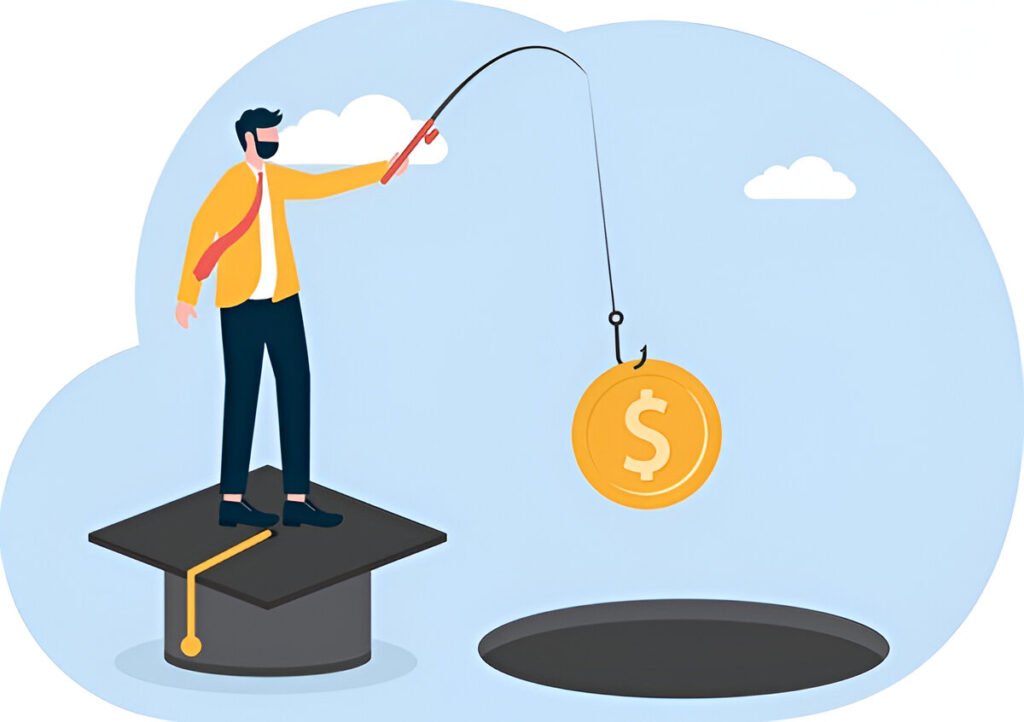Introduction
It starts with excitement—you’ve just been accepted into your dream college. You get the welcome packet, the campus map, and then… the financial aid offer. You see the words “loan” and “approved” and think, Perfect! This will cover everything I need.
Fast forward four years, and you’re graduating with a degree, but also with tens of thousands of dollars in debt. Suddenly, those “helpful” loans feel like a trap. Payments start, interest piles up, and you realize no one really prepared you for this.
That’s why learning how to avoid student loan traps is critical before you borrow a single cent. In this guide, we’ll break down common mistakes, share real-life lessons, and give you expert-backed strategies to graduate with a degree—not a mountain of debt.
Why Avoiding Student Loan Traps Matters More Than Ever
Student loan debt in the U.S. has reached staggering levels—over $1.74 trillion according to the Federal Reserve. The average borrower leaves college with more than $28,000 in debt. For many, this means delaying home ownership, postponing retirement savings, or passing on dream jobs in favor of higher-paying ones just to keep up with loan payments.
The problem isn’t just the size of the loans—it’s how they’re structured. Interest starts adding up quickly. Repayment plans can be confusing. And some private loans have fewer protections than federal ones, leaving students vulnerable.
Understanding the traps before you sign the dotted line could save you thousands—and years of financial stress.
My Personal Experience with Student Loan Decisions
When I applied for college, I was so focused on getting in that I barely looked at the loan terms. I accepted both federal and private loans without fully understanding interest rates or repayment timelines.
It wasn’t until my final year that I realized how much I’d actually owe. A friend of mine had taken a different route—she applied for every scholarship possible, chose a more affordable school, and worked part-time. She graduated with less than $5,000 in debt.
Looking back, I wish I had approached loans with the same caution. The truth is, once you sign for that money, you’re agreeing to repay it no matter what happens after graduation.
Common Student Loan Traps to Watch Out For
One of the biggest traps is borrowing more than you actually need. Many students accept the full loan amount offered without realizing they can request less. That extra money might feel nice in the short term, but it comes with long-term costs.
Another trap is choosing private loans without exhausting federal options first. Federal loans generally offer lower interest rates, income-driven repayment plans, and even forgiveness programs—benefits you rarely get with private loans.
Then there’s the trap of ignoring interest. Unsubsidized loans start accumulating interest while you’re still in school. If you’re not paying attention, you can graduate owing far more than you borrowed.
Comparing Student Loan Types and Risks
| Loan Type | Interest Rate Range (2025 Avg) | Interest Accrual While in School | Repayment Flexibility | Key Risks |
|---|---|---|---|---|
| Federal Subsidized | ~5.5% | No | High | Limited borrowing amount |
| Federal Unsubsidized | ~5.5% | Yes | High | Growing balance before graduation |
| Federal PLUS Loans | ~8% | Yes | Moderate | Higher interest rates |
| Private Loans | 4–15% | Usually Yes | Low–Moderate | Variable rates, fewer protections |
Expert-Backed Tips to Avoid Student Loan Traps
Financial experts consistently recommend starting with a cost-first mindset when choosing a school. A lower-cost college might not have the same prestige as an expensive private one, but graduating debt-free can be far more valuable in the long run.
Another tip is to budget as if you already have loan payments. For example, if your projected payment is $250 a month after graduation, start putting that amount in a savings account now. This not only prepares you for repayment but also builds a cushion.
Consider working part-time during school. Even a modest income can reduce how much you need to borrow. The U.S. Department of Education notes that every $1,000 you avoid borrowing saves you significantly more over the life of the loan once interest is factored in.
Real-Life Case Example: How One Student Graduated Nearly Debt-Free
Take Jenna, a student who initially planned to attend a private university with a $45,000 annual price tag. After reviewing loan offers, she realized she’d graduate with over $120,000 in debt. Instead, she chose a respected state school with in-state tuition of $12,000 a year.
She also applied for need-based grants, academic scholarships, and worked 15 hours a week at a local coffee shop. She limited her borrowing to just $10,000 in federal subsidized loans. By living with roommates and budgeting carefully, Jenna graduated with a manageable debt load that she paid off within three years.
Practical Strategies for Safer Borrowing
Before accepting any loan, make sure you fully understand the terms. Read the fine print on interest rates, repayment schedules, and whether the loan is fixed or variable. Fixed rates stay the same, while variable rates can increase over time.
Pay attention to the grace period—the time you have after graduation before payments start. Most federal loans give you six months, but some private loans require payments immediately.
If you take unsubsidized loans, consider making small interest payments while in school. Even $25 a month can prevent your balance from ballooning.
Finally, don’t assume you’ll qualify for loan forgiveness. While programs like Public Service Loan Forgiveness exist, they have strict requirements and are not guaranteed.
Using Tools and Resources to Stay Informed
| Resource | Purpose | Why It Helps |
|---|---|---|
| Federal Student Aid (studentaid.gov) | Official federal loan information | Helps you compare loan types, rates, and repayment options |
| College Scorecard | Compare schools’ costs and graduation rates | Gives real-world data to guide your college choice |
| CFPB Student Loan Calculator | Estimate monthly payments | Shows the long-term impact of different borrowing levels |
| Scholarship Search Engines | Find non-loan funding | Reduces reliance on borrowing |
What Experts Say About Smart Borrowing
Forbes finance columnist Zack Friedman explains that borrowing should be a last resort:
“Every dollar you borrow is a dollar you must repay—with interest. Minimize borrowing to what’s essential, and remember you have other funding options like grants, work-study, and scholarships.”
The U.S. Department of Education also advises students to “borrow only what you need, and understand how repayment works before you accept the loan.”
These are not just guidelines—they’re survival strategies in an economy where student loan debt can follow you for decades.
Final Thoughts: Taking Control Before Debt Controls You
Avoiding student loan traps isn’t about avoiding loans altogether—it’s about borrowing wisely. Start by researching all your options, keeping costs low, and thinking about repayment before you commit.
The most successful graduates are those who treat student loans as a serious financial decision, not just a formality. They ask questions, compare offers, and have a plan for repayment from day one.
Your future self will thank you when you graduate with a degree and the freedom to build your life without overwhelming debt.
FAQs
1. What’s the safest type of student loan?
Federal subsidized loans are generally the safest because they have lower interest rates, flexible repayment options, and don’t accrue interest while you’re in school.
2. Should I avoid private loans entirely?
Not necessarily, but they should be a last resort after exploring all federal and non-loan funding sources.
3. Can I negotiate loan terms?
You can’t negotiate federal loan rates, but you may be able to shop around for better terms with private lenders.



